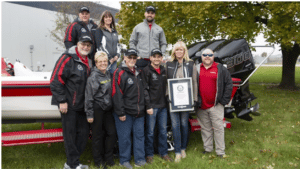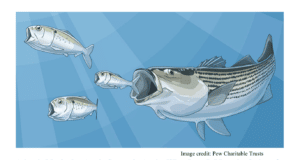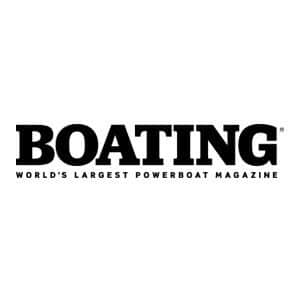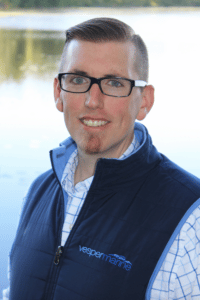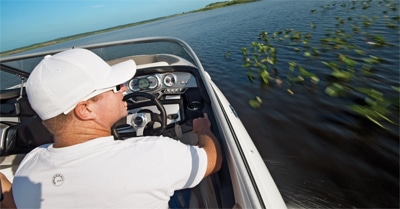
Sea-Doo
Cutting Gas by the Hour
Let’s say you’re planning to put 10 hours of general cruising time on your boat during the next two weeks. What if you were told you could save 25 gallons of gas during those outings by pressing a button on the dash? You’d have to say, “Show me the button!”
It’s true. The eco (or fuel economy) mode on the Sea-Doo 210 Challenger gives better gas relief than Beano. Here’s how: the computer at the heart of the boat’s intelligent throttle control (iTC) feeds information to the engine, regulating not only the amount of power the engine delivers but also how it’s delivered — in a burst, gradually or steadily. This is all at the driver’s discretion and controlled with a little button on the dash. With the button, you toggle through four modes — ski, cruise, docking and eco, which is the one that gripped us during two separate tests. In eco, the computer found the most efficient fuel flow once the boat was on plane. The computer continued to adjust the engine output as it read changes in current, water temperature, air temperature, barometric pressure and load. We didn’t have to do anything.
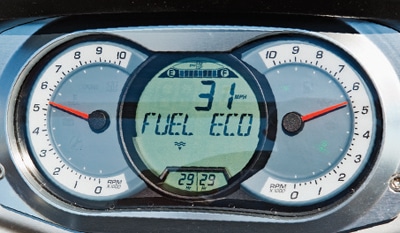
If you’re like most sport boaters, you’ll guess at the most economical cruise speed on your ride. You could be 5 mph off, easily. In our test, 5 mph over the most fuel-efficient speed had us burning 11 gallons per hour (gph) of gas. Eco mode had us at 8.5 gph. Over 10 hours, that’s a difference of 25 gallons if you’re just cruising. Make it 50 hours and you’re looking at a potential waste of 125 gallons, just by missing the mark.
The eco mode was introduced on the 210 Challenger last fall. It was such a hit that Sea-Doo will offer the function on six boat models and three watercraft for the 2011 model year. Over time, that will equate to a lot of gas savings when the right buttons are pushed. — Robert Stephens
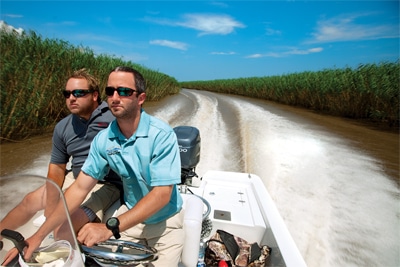
Louisiana’s Coastal Conservation Association Members
Moving Forward, In a Messy Situation
Everyone was talking about oil in the Gulf of Mexico. Looking at pictures of oil in the Gulf. If we were to compile our first Eco Awards winners, honoring the people and products having positive impacts on the boating environment, then in the aftermath of the April 20 explosion of Deepwater Horizon, we had to stick our hands into the oil too. Or at least make the effort.
So the call came to David Cresson’s iPhone, deep in the wetlands of Louisiana. He knew it was another media outlet reaching for an oil cleanup story.
“I’d like to give you what you’re looking for,” said Cresson, executive director of Louisiana’s chapter of the Coastal Conservation Association (CCA). “The truth is, they don’t want our members out there with shovels and buckets. We could have a thousand boats ready to go out and help tomorrow. But come on down and I’ll show you what we are doing.”
Six days later, with two bay boats in tow, we were in a caravan — Cresson, CCA Louisiana fish-tagging coordinator Tony Berrigan, CCA volunteers Sam Elliott and Paul Roberts, photographer Cy Cyr and I — traveling through the thick pre-dawn darkness toward the Gulf. Past mile upon mile of oil refineries, tanks and pipes. Past an emergency response center. Right up to a line of boats at Venice Marina, touted on signage as the “Fishing Capital of the World. ”Less than half of the men were here to fish on this August morning.
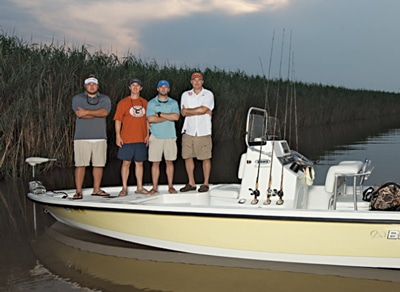
“Workers,” said Elliott, looking at boaters wearing telltale orange vests. The word workers had become new vernacular over the summer, referring simply to oil cleanup crews.
Elliott and his fellow CCA members were wary of losing perspective. Two days after the Deepwater Horizon exploded and caught fire, Cresson was notified that a friend, 28-year old Gordon Jones, was one of the 11 people missing from the rig. (His wife, Michelle, would give birth to their son three weeks later.) On April 30 Elliott towed his 21-foot Champion to the port in Hopedale, where he hoped to volunteer for the cleanup and instead found a media frenzy at the docks. “They were asking me to take ’em to oil,” he said. “They wanted pictures. That’s all they wanted.”
Then came the cataclysmic stories and the blaming and the “who’s gonna fix this?!”
“We purposefully stayed out of the finger-pointing,” Cresson said of the 15,000 CCA members. “After the initial shock of the tragedy, we just wanted to go out and start repairing.”
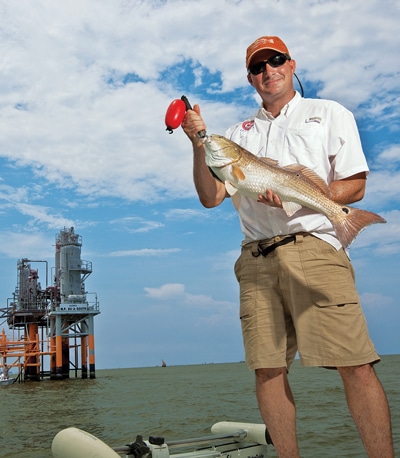
Repairing meant catching fish and tagging them. The CCA’s tagging program has helped track one of the world’s healthiest fish populations for more than 20 years, providing health reports on dozens of species.
“We don’t know yet how the oil situation will impact the fish habitat long-term,” Berrigan said. “It’s never been more important for us to be out here.”
So, while workers looked for tar balls and reporters looked for oiled wildlife, we motored outside Flatboat Pass, 22 miles through cuts and sloughs, before tying lines to, of all things, the pilings of a natural gas platform. Within 10 minutes a drum and a ladyfish were boated, tagged and released. By lunchtime we’d pulled jacks, catfish, trout and 24 redfish from the water. Most were tagged. Some were dropped into an ice chest to be filleted later.
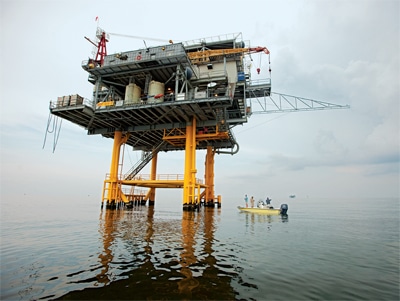
“The fish are healthy now,” Roberts said. “The concern is the spawn. If fewer eggs survive, we’ll have fewer fish. Fewer fish, fewer eggs. It would be a downward spiral from there.”
The CCA has helped draw up plans for a fish hatchery along the Louisiana coast, something that was never needed before but might now help save a multibillion-dollar recreational fishing industry. There’s concern in the conversation, but hope in the tone.
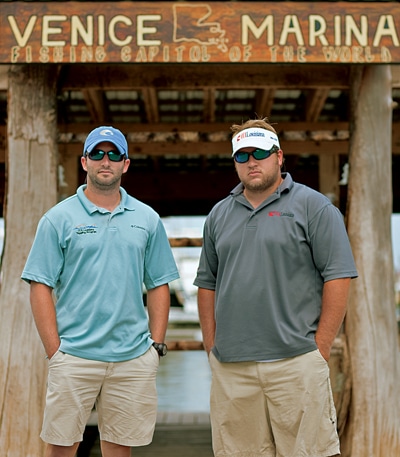
“When the last camera is turned off,” Cresson told a congressional subcommittee in Washington, D.C., following the spill, “and when the rest of the world is no longer focused on the Gulf of Mexico, we will still be here, as we always have been, ready to do what needs to be done.”
For our first eco Awards, we reached out for a story about the oil. It never crossed our minds that the story might instead take us fishing. — R.S.
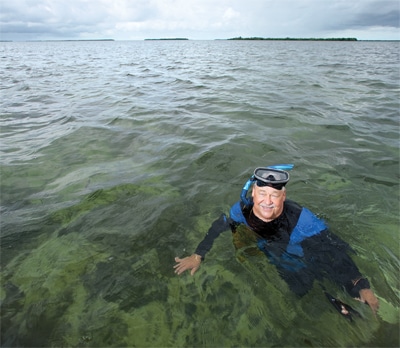
Billy Causey
Preserving a Key Boating Destination
The 4 million annual visitors to the Florida Keys could test Billy Causey’s patience. The majority of them are towing boats, or renting them, to play on one of the most sensitive marine ecosystems in North America. So what does Causey, the man who helped establish the Florida Keys National Marine Sanctuary 20 years ago, do? He joins them.
“None of us wants to boat or dive in a broken-up, disassembled, dirty environment,” says Causey, 66, who explores the 2,896-square-mile sanctuary in a 22-foot Mako, circa 1989, for recreation. “I’m not sure what things would look like if changes hadn’t been made.”
In the summer of 1990, Causey saw that the fire coral, which made the Keys the most heavily dived area in the world, was turning stark white. The numbers of sponges and anemones were dropping. It wasn’t just the environment that was taking it on the chin. So were recreational boats. More than 600 would ground that year, damaging seagrass and reefs with even the slightest impact.
“The sanctuary isn’t to punish boaters for a mishap, or to tell them where to go,” Causey says, “but to make it safer and easier to enjoy these resources, and make sure they’re here in the future.”
Still, many a crooked eye has been directed at causey from boaters suspicious of water regulations.
“A few years ago I went out with him to look at some areas where they proposed changes,” says Steve Leopold, president of the Islamorada Charter Boat Association. “I was a little skeptical about what he might want to do, but there was obvious abuse out there. Instead of making a snap decision on his own, he asked my thoughts. We came up with some ideas right there on the water. That’s far better than having decisions driven by lobbyists and environmental groups who don’t know the area. Billy’s the real deal.”
So when swarms of visiting boaters are avoiding seagrass beds because of a vastly improved marker system, and tying up to mooring balls a safe distance from coral heads, it’s likely that Billy Causey is out there with them. — R.S.
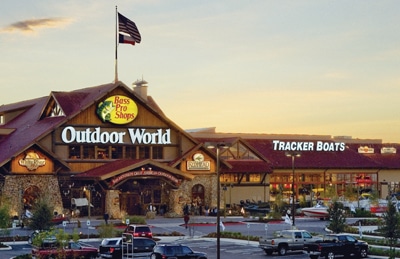
Bass Pro Shops and Tracker Marine
Investing in Wildlife Habitat
Tree huggers might be surprised to learn that the world’s largest retailer of hooks, tackle and bass boats is also a champion of conservation and wildlife preservation. But Bass Pro Shops and Tracker Marine customers are not surprised. Leaf through any of the 50 million catalogs they print on recyclable paper, or wander through the eye-bugging dazzle of an Outdoor World, and you’ll see the respect the company has for our environment, our waterways and wildlife.
Since Johnny Morris founded Bass Pro Shops in 1972 (and Tracker Marine a few years later), no cause has persuaded his company to open its wallet more generously than conservation of our wild resources. Tracker Marine has been a leader in reducing toxic chemicals from its boatbuilding process, and both Bass Pro Shops and Tracker have increased energy efficiency of their plants and warehouses. Both have followed the motto “reduce, recycle, reuse.”
As leaders in recruiting conservationists, Bass Pro Shops and Tracker helped establish the National Reservoir Fisheries Habitat Partnership to develop “Friends of the Reservoirs” organizations, which raise funds, provide manpower and enhance habitat nationwide. The latest and perhaps most poignant initiative is partnering in the establishment of the National Fish Habitat Action Plan, then pledging $2.5 million to launch the Table Rock Fish Habitat initiative, the first project under a plan fostered by the National Fish and Wildlife Foundation.
So, in our book, Bass Pro Shops and Tracker Marine are what eco-green tree-and bunny-hugging is all about. — Randy Vance
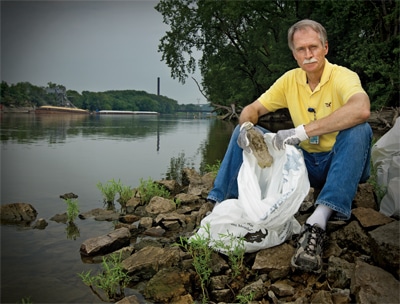
Paul Nordell
Taking Out the Trash
On autumn afternoons in the late 1980s, Paul Nordell would find a grassy spot overlooking a gorge on the Mississippi River just upstream from his office in St. Paul, Minnesota. He enjoyed the solitude, but not much else.
“It smelled,” Nordell says. “I’d watch kids weaving their bikes between refrigerators and appliances that had been dumped there. A few good rainfalls and that stuff was in the river.”
All over the state people would drive out to the countryside where nobody could see them doing their dastardly deeds with paint cans, car parts and anything that couldn’t be sold out of a garage. In the land of 10,000 lakes and umpteen hundred rivers, guess where the junk eventually wound up? Everyone found out in June 1988 when volunteers collected 80 tons of crap from a section of the Mississippi River in one day.
A year later, Minnesota’s Department of Natural Resources birthed an Adopt-A-River program, and in 1991 Nordell became its coordinator. Since then, 80,000 volunteers have picked up 5.8 million pounds of garbage from 9,500 miles of public waterways. Some 300,000 tires alone have been pulled from a site along the Minnesota River in Belle Plaine before they could float away.
“We used to call Belle Plaine the No. 1 exporter of tires to the Twin Cities,” says Nordell, whose group sends the tires to clean-burning power plants and to makers of synthetic athletic fields.
One of Nordell’s favorite days is when he takes fourth- through sixth-graders out for what he calls Mississippi River: CSI. The students get a bag of river trash to figure out how each item got into the water. The smoking gun rarely points to boaters. The kids find tire tracks on a fast-food bag, or a can crushed by a shoe, and figure out that the garbage starts in the streets and escapes to the water.
“There have been huge changes in awareness in the past 20 years,” Nordell says. “I can look around today and appreciate the beauty of the water, not just listen to it. But we don’t know if the job is done, so we don’t dare stop.” — R.S.
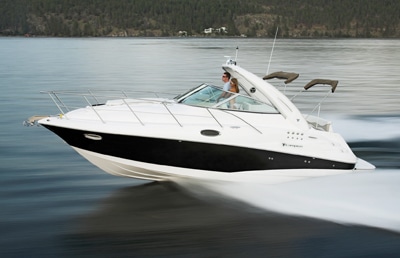
Campion Boats and Ashland Performance Materials
Building Earth-Friendly Boats
The largest boat manufacturer in Canada is now building boats from the ground up, so to speak. Campion started down this unpaved road nearly three years ago, when it agreed to test a new resin called Envirez from Ashland. The resin, which replaces petroleum with soy oil, was first used to build two sample boats, both 20-ish bowriders.
“There were jokes that if the tests didn’t work out we could eat the boats,” says Campion designer Peter Wingfield. “We weren’t holding our breath.”
The boats were abused on Lake Okanagan near Campion’s factory in Kelowna, British Columbia. If the hulls didn’t hold up to two seasons of tests, then Envirez wouldn’t make the menu on a single Campion boat. The verdict? Campion is now building all 37 of its boat models with Envirez.
Engineers at the National Marine Manufacturers Association have told Boating they’re excited about the prospects for Envirez. Each 38,000-pound batch of the bio-based resin eliminates the use of 10 barrels of crude oil, with soy and corn in its place. Envirez also reduces the amount of styrene, a volatile organic compound (VOC) emitted during construction, making for a healthier working environment.
Now that Campion is all in, as many as 10 boatbuilders are testing Envirez. “I’m betting they’ll see the benefit of a better product and a smaller environmental footprint,” says Ashland’s product manager, Bob Moffit. And we’re betting he won’t have to eat his words. — R.S.
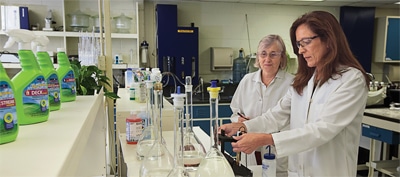
Thetford Marine
Mixing Greener Cleaners
If you ever had thoughts of being a scientist as a kid, this is where you wanted to be — experimenting in the lab at the Thetford Corp. in Ann Arbor, Michigan. Here, it’s as if you’ve entered a boat bakery, and anything goes. You’re surrounded with swatches of vinyl seat covers, pieces of windshields and chunks of unpainted aluminum. Over on bookshelves are samples of the brainiac stuff: dyes and fragrances; surfactants and hydrotropes; chelating agents and … more stuff.
“Sometimes it seems like black magic,” says Mary Burrows, the senior of Thetford’s three full-time chemists. “We’re trying to create something that cleans but doesn’t harm the environment. All from scratch.”
Thetford committed its cleaning products three years ago to the Design for the Environment (DFE) standards. It could have chosen an unsubstantiated green label from the dozens available on the Internet, which is what some companies have done without changing their formulas much. It would have been easier. The DFE folks couldn’t give much direction to Burrows, except to start and end every conversation with “no.”
Because boat cleaners are released directly outdoors, the DFE requirements are far stricter than the standards for household products. These boat cleaners can’t harm aquatic life. Can’t accumulate in the environment. No phosphates. No deodorizers. It was like being asked to make chicken noodle soup, without using chicken or noodles, and, oh, it has to be natural.
“We had to figure it out,” Burrows says. “There were a lot of hours and a lot of rejections.”
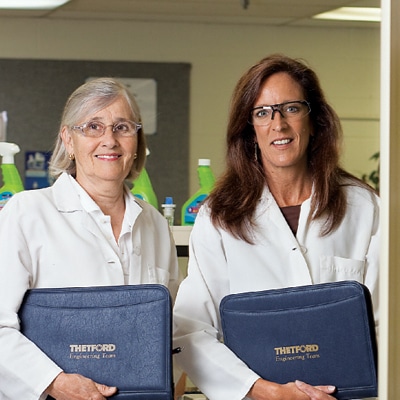
Some of the lukewarm reactions came from Thetford’s panel of 500 field testers. But after a year, the ladies in the lab coats landed on a few potions. They’re now serving up six DFE-approved products, some in their second and third generations.
“There’s nothing like hands-on experimenting,” Burrows says. And so in her lab there are boat parts soaking in new concoctions. There’s mixing and messing. Makes you again want to be a scientist. — R.S.
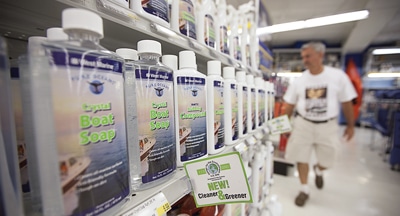
West Marine
Stocking a Healthy Market
A retailer the size of West Marine wields tremendous power. What this mega giant offers for sale ultimately affects what we perceive as our choices in boating gear and, in the end, what we buy. There may be phenomenal products out there, but if we don’t see them — if West doesn’t carry them — we might never know they exist.
Since 2007 West Marine has become serious about pushing eco-friendly products (more than 115 were offered in 2009) and getting the message out that, as chief sustainability officer Laurie Fried puts it, “the oceans and all waters are our responsibility. If we abuse them, we all lose.” It’s both a savvy business decision and an emotional one, having become a core part of West Marine’s corporate culture.
Through this ideology, West annually offers a $30,000 marine conservation grant to nonprofit conservation or recreational fishing groups, and a $10,000 Green Product of the Year Award. It also has its own line of Pure Oceans products developed to standards set by the EPA’s Design for the Environment (DFE) program, which reviews the ingredients for potential human health and environmental effects. Want numbers? The company estimates that in 2009 the products it sold were capable of reducing harmful chemicals released into the environment by about 230,000 pounds.
Which is why, in West Marine’s case, bigger really is better. With a marketing clout of more than 330 stores worldwide, its product choices and the message it brings, it is both global and green. — David Seidman
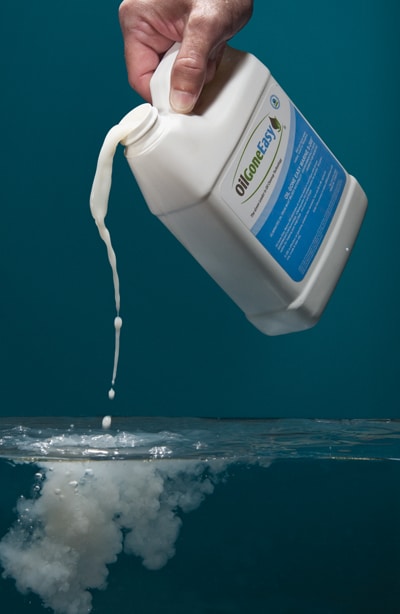
Oil Gone Easy
Returning Water to Nature
If you accidentally spill fuel or oil overboard, you’re responsible for damages and can be fined up to $10,000. And don’t try to clean it up with dispersants containing detergents. They only contribute to the pollution and could cost you an additional $25,000.
There aren’t many good options for removing oil from bilges either. Soaps marketed as “bilge cleaners” are just dispersants and shouldn’t be pumped into the water. You can use absorbent pads or rolls, but they’re a mess to handle once full. There are also expensive oil separators for the bilge pump’s discharge line. A cleaner option is Oil Gone Easy’s Marine S-200 to deal with both what’s in your bilge and overboard spills.
In the aftermath of the Exxon Valdez disaster in Alaska in 1989, a new approach to removing the oil, called bioremediation, was tried. A nutrient is spread on the oil to promote the rapid growth of natural oil-decomposition bacteria. It feeds only the helpful bacteria, which, after consuming the hydrocarbons, feed on each other to return the bacteria population back to pre-spill levels.
It worked but had some problems that Jim Lynn, a chemical engineer at another oil giant, began to address. Once solved, the company he worked for said it was more interested in drilling for oil than cleaning it up. So Lynn went out on his own with S-200, which has been successfully used on major industrial oil spills worldwide and is now available for our much-smaller boat cleanups. — D.S.

